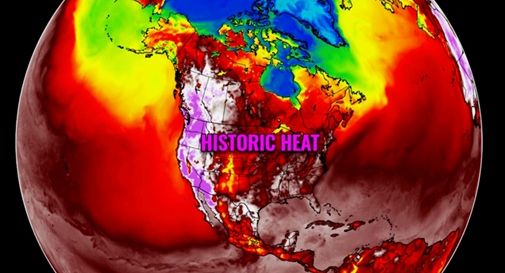Un caldo da record
Una micidiale "cupola di calore" è scesa sulla mia città e sul Pacifico nord-occidentale. Predetto dagli scienziati del cambiamento climatico per decenni, la realtà sembra astratta finché non accade a te.
| Richard Brewer |

RUBRICA - Bend, Oregon, 29 giugno 2021. Uscii e sentii un'aria rovente avvolgermi. Rendeva la respirazione difficile, soffocante, debilitante. La strada davanti a noi luccicava mentre le ondate di calore si alzavano dall'asfalto. Era secco come l'osso, la città che cuoceva in forno. Il nostro serbatoio d'acqua Wickiup locale era al minimo storico e si stava surriscaldando, uccidendo i pesci. Mi è venuto in mente la Death Valley, in California, visitata anni fa quando ero più giovane e più tollerante al caldo. Ma ora sono più vecchio e questa non era la Death Valley, ma la mia città natale di Bend, nell'Oregon, un'ex comunità di taglialegna circondata da foreste, laghi e fiumi. Ed è solo giugno. Non dovrebbe essere così.
Una micidiale "cupola di calore" è scesa sulla mia città e su milioni di persone nel Pacific Northwest, portando temperature di 28 gradi sopra la media. Domenica Bend ha raggiunto 37.8 C , lunedì 41.1 C e martedì abbiamo raggiunto 42,8 C. A Portland, nell'Oregon, 195 km a nord-ovest di noi, c'erano 44,4 C. Il giorno successivo ha visto Portland raggiungere i 46,7 C, le temperature più alte che avesse mai registrato. 402,4 km a nord-ovest di noi, Seattle, Washington ha raggiunto 42,2 C il giorno più caldo mai registrato lì. Prima di questo aveva registrato solo tre giorni sopra 37,8 C in tutta la sua storia, nessuno a giugno. Più a nord, la città di Lytton, nella Columbia Britannica, ha raggiunto 49.6 C la temperatura più alta mai misurata in Canada. A preoccupare è il largo scostamento dalle norme storiche.
Il sistema infrastrutturale di Portland ha iniziato a sciogliersi. 4.000 persone erano senza potere. Quando le temperature hanno raggiunto i 44.4 C, un cavo di alimentazione su un ponte principale si è deformato e attorcigliato ed è stato bruciato e per evitare che la superficie del ponte si piegasse mentre si espandeva a causa del calore, è stato necessario lavarlo con acqua. Nel frattempo, i fili che correvano sopra i binari del tram del centro si espansero e si abbassarono così tanto da rischiare di toccare i vagoni del tram e quando i cavi elettrici rivestiti in gomma si sciolsero, il sistema fu spento. Le strade, costruite per un'epoca diversa, hanno cominciato a deformarsi e a rompersi sotto il caldo. Una piscina, usata per sfuggire al caldo, ha dovuto essere chiusa perché il marciapiede del ponte abbronzato a mezzogiorno si avvicinava a 76.7 C.
Questa ondata di caldo nel Pacific Northwest ci mostra quanto siamo davvero impreparati. Non eravamo preparati e non potevamo resistere a questo incontro straziante con un'ondata di caldo provocata dal riscaldamento climatico.
Anche se può sembrare provinciale, la mia preoccupazione per il Pacifico nord-occidentale, o l'Oregon, o in particolare la mia piccola città di Bend, ciò che è importante è il fatto che questo sia rappresentativo di ciò che il mondo sta affrontando ignorando la nostra crisi climatica. Stiamo vivendo una minaccia futura per il mondo se non vengono apportate modifiche e apportate presto.
La logica di base del presidente Biden di includere il cambiamento climatico in un quadro infrastrutturale per gli Stati Uniti è solida. La costruzione di infrastrutture fisiche per far fronte al clima che diverge dalle sue norme di lunga data deve iniziare ora. I servizi pubblici nel Pacific Northwest dovranno costruire una rete elettrica in grado di resistere a temperature così elevate estreme pur rispettando il clima. Siamo tutti in questo insieme.
Per decenni gli scienziati del cambiamento climatico hanno previsto che avremmo potuto sperimentare ondate di calore più lunghe e intense insieme a una siccità estrema. Tali periodi prolungati di calore eccessivo come questo non solo torneranno, ma più frequentemente e persino più estremi. Siamo già in un periodo di grave siccità in Oregon, che colpisce la nostra agricoltura e la fauna selvatica locali e la nostra vegetazione secca e arida e le foreste sono destinate a diventare una polveriera per gli incendi che infurieranno fuori controllo quest'estate.
Il caldo estremo, un evento meteorologico mortale guidato dal cambiamento climatico, è una minaccia silenziosa che ci sta perseguitando in questo momento e quando arriva uccide. Non possiamo permetterci di aspettare in silenzio. Prego che tutti noi ci svegliamo davanti al pericolo e agiamo insieme per mitigare la nostra crisi climatica in tutto il mondo... ora!
****************IN ENGLISH **************

A Record Shattering Heat
A deadly ‘heat dome’ has descended on my city and on the Pacific Northwest. Predicted by climate change scientists for decades, the reality seems abstract until it happens to you. A sign of the future — nowhere, no place, is prepared for it. The world must confront the climate crisis.
Bend, Oregon 29 June 2021. I stepped outside and felt blistering hot air envelop me. It made breathing difficult, suffocating, debilitating. The road ahead shimmered as heat waves rose up from the asphalt. It was bone dry, the city baking in an oven. Our local Wickiup water reservoir was at an all time low and heating up, killing off the fish. I was reminded of Death Valley, California, visited years ago when I was younger and more heat tolerant. But I am older now and this was not Death Valley but my hometown of Bend, Oregon, a former logging community surrounded by forests, lakes and rivers. And It is only June. It shouldn’t be this way.
A deadly ‘heat dome’ has descended on my city and on millions of people in the Pacific Northwest, driving temperatures 50 degrees above average. Sunday Bend reached 100 F., on Monday 106 F and on Tuesday we reached 109 F. In Portland, Oregon, 195 km to the northwest of us,, it was 112 F. The next day saw Portland reach 116 F, the highest temperatures it had ever recorded. 402.4 km to the northwest of us, Seattle, Washington reached 42.2 C (108 F) the hottest day ever recorded there. Prior to this It had only recorded three days over 100 F in its entire history —none in June. Farther to our North, the town of Lytton, British Columbia reached 121.3 F the highest temperature ever measured anywhere in Canada. It is the large departure from historic norms that is worrying.
The Portland infrastructure system started to melt. 4,000 people were without power. As temperatures reached 112 F a power cable on a major bridge warped and twisted and was scorched and to prevent the bridge surface from buckling as it expanded from the heat, they had to hose it down with water. Meanwhile, wires that ran above the downtown streetcar track expanded and sagged so much it risked touching the tram cars and as rubber lined power cables melted, the system was shut down. Roads, built for a different era, began to buckle and break up under the heat. One swimming pool, used to escape the heat, had to be shut down because the sunbaked deck pavement at midday approached 170 F.
This heat wave in the Pacific Northwest shows us how truly unprepared we are. We were not prepared for, and could not withstand, this wrenching encounter with a warming climate driven heat wave.
While it may seem parochial, my concern about the Pacific Northwest, or Oregon, or specifically my small town of Bend, what is important is the fact that this is representative of what the world is facing by ignoring our climate crisis. We are experiencing a future threat to the world if no changes are made and made soon.
President Biden’s basic logic of including climate change in an infrastructure framework for the U.S. is sound. The construction of physical infrastructure to contend with the climate diverging from its long time norms must begin now. Utilities in the Pacific Northwest will have to build a power grid that can withstand such extreme high temperatures while being climate friendly. We are all in this together.
For decades climate change scientists predicted we could experience longer, more intense heat waves along with extreme drought. Such extended periods of excessive heat like this will not only come again, but more frequently and even more extreme. We are already in a period of severe drought in Oregon, affecting our local agriculture and wildlife and our parched dry vegetation and forests are set to become a tinderbox for wild fires that will rage out of control this summer.
Extreme heat, a deadly weather event driven by climate change, is a silent threat that is stalking us right now and when it arrives it kills. We can’t afford to wait in silence. I pray we all wake up to the danger and act together to mitigate our climate crisis world wide … now!


